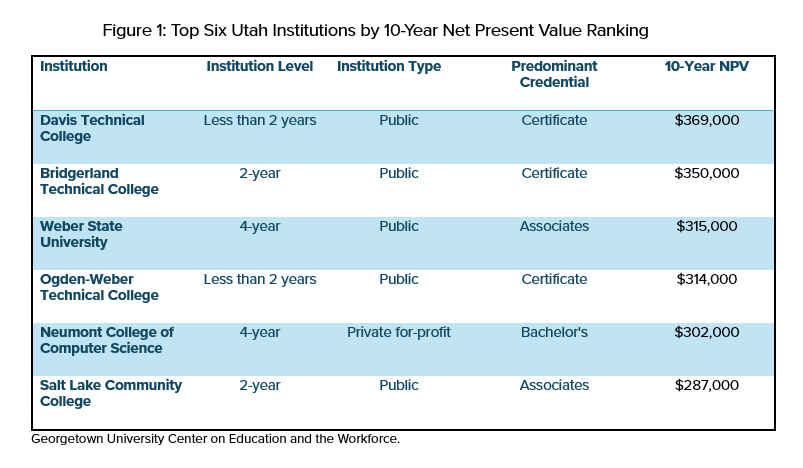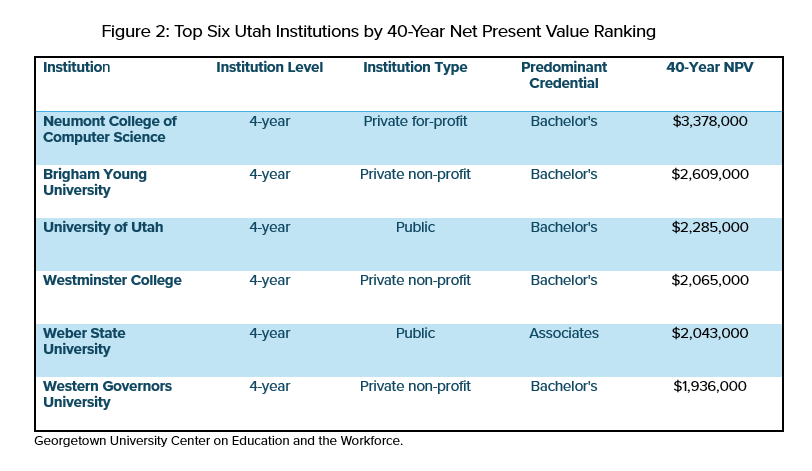BACKGROUND
As students seek further education to improve their career and earning potential, understanding the long-term value of investment is essential. Determining the return on investment, due to various factors, is not always straightforward. The cost of attendance, student debt, graduation rates, and earnings all influence return on investment, and their impact varies across institutions and programs.
To support informed decision-making, tools such as the U.S. Department of Education’s College Scorecard provide valuable insights.[1] These metrics, although limited, offer valuable information on costs and outcomes for assessing economic value. The Georgetown Center on Education and the Workforce extends this by calculating net present value, which compares the cost of education to projected earnings.[2]
This research brief applies that approach to post-secondary education across Utah, using recent data to compare outcomes by credential level, institution type, and time frame.
RETURN ON INVESTMENT
Utah’s 10-year net present value data highlight strong returns across different institutional levels and credential types – including certificates, associates degrees, and bachelor’s degrees – offered by both public and private institutions.
Public technical colleges that offer certificates, such as David Technical College and Bridgerland Technical College, top the list, with net present values exceeding $350,000, outperforming four-year institutions. This may be surprising, but it is important to note that certificates are typically less expensive pursuits, and receiving a certificate within a year or so enables students to start earning higher wages much sooner than their peers pursuing four-year degrees.
When compared to the Georgetown Center on Education and the Workforce’s earlier study, the more recent net present values are noticeably higher, and the rankings include a greater proportion of certificate programs among the top-performing institutions.[3] This indicates an increase in the value of enrolling in certificate programs for further learning or career advancement.
In terms of 40-year net present value data, most top rankings consist of four-year institutions and bachelor’s degrees. This indicates that four-year institutions offer more sustained earnings over time and reliable economic returns. Again, net present values have increased since the earlier study, which suggests that the long-term economic return has grown over time.[4]
METHODOLOGY
Data from the Georgetown Center on Education serves as a primary source for this report.[5] The center uses various variables from the U.S. Department of Education’s College Scorecard, which includes information on 4,600 schools.[6] It includes the students’ median earnings of 6 years, 8 years, and 10 years after they enroll at an institution, the average net price of the institution, and the predominant credential awarded at the institution, for the 2021-2022 school year.
Using these three different variables, return on investment is calculated at intervals of 10, 15, 20, 30, and 40 years after initial enrollment at an institution. It is calculated as the cumulative sum of earnings minus the total out-of-pocket costs based on the average net price.
The average net price consists of the average out-of-pocket cost paid by full-time, first-time students who receive federal financial aid to attend one year of school. Therefore, the data in the College Scorecard covers only students receiving some form of federal financial aid.
This post was written by Research Intern Bala Tella.
[1] U.S. Department of Education. College Scorecard. Accessed July 2, 2025. https://collegescorecard.ed.gov/
[2] Georgetown University Center on Education and the Workforce. Ranking 4,600 Colleges by ROI (2025). February 2025. Accessed July 2, 2025. https://cew.georgetown.edu/cew-reports/roi2025/
[3] Utah Foundation. Bang for Your Buck: Which Utah Schools Have the Best Return on Investment. August 2023. Accessed July 2, 2025. https://www.utahfoundation.org/reports/bang_for_your_buck_return_on_investment/
[4] Ibid.
[5] Georgetown University Center on Education and the Workforce. Ibid.
[6] U.S. Department of Education. Ibid.
Categories:



